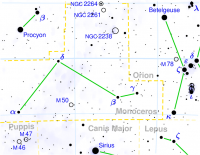CoRoT-7
Da Ufopedia.
(→References) |
(→Planetary system) |
||
| (Una revisione intermedia non mostrata.) | |||
| Riga 9: | Riga 9: | ||
==Location and properties== | ==Location and properties== | ||
| - | The star is located in the '''LRa01''' field of view of the [[COROT|COROT spacecraft]]. According to the project website this field is in the [[Monoceros constellation]].<ref name="symp09" /> The discovery paper lists the stellar properties as being a [[stellar classification|G9V type star]] with a temperature of 5275 [[Kelvin|K]], a radius of about 87% of the Sun and a mass of about 93% of the Sun. The star has roughly the same amount of metals as the Sun: the quantity [M/H], which is the base-10 logarithm of the ratio of the star's metal abundance (given by the ratio of metals to hydrogen) to that of the Sun is 0.03 ± 0.06, which corresponds to a range 93% - 123% of the solar metal abundance with a best fit value of 107%. The star is estimated to be about 150 parsecs away and with an age in the range 1.2 – 2.3 billion years, is younger than our own star which has an age of 4.6 billion years. | + | The star is located in the '''LRa01''' field of view of the [[COROT|COROT spacecraft]]. According to the project website this field is in the [[Monoceros constellation]].<ref name="symp09" /> The discovery paper lists the stellar properties as being a [[stellar classification|G9V type star]] with a temperature of 5275 [[Kelvin|K]], a radius of about 87% of the Sun and a mass of about 93% of the Sun. The star has roughly the same amount of metals as the Sun: the quantity [M/H], which is the base-10 logarithm of the ratio of the star's metal abundance (given by the ratio of metals to hydrogen) to that of the Sun is 0.03 ± 0.06, which corresponds to a range 93% - 123% of the solar metal abundance with a best fit value of 107%. The star is estimated to be about 150 parsecs away and with an age in the range 1.2 – 2.3 billion years, is younger than our own star which has an age of 4.6 billion years. |
This star has been reported to be [[Asteroseismology|seismically active]], making the confirmation process for the planet more difficult.<ref name="spitzer">{{cite web | This star has been reported to be [[Asteroseismology|seismically active]], making the confirmation process for the planet more difficult.<ref name="spitzer">{{cite web | ||
| Riga 18: | Riga 18: | ||
== Planetary system == | == Planetary system == | ||
| - | The star is reported to be orbited by the [[super-Earth]] [[extrasolar planet]]s [[COROT-7b]] and [[COROT-7c]]. | + | The star is reported to be orbited by the [[super-Earth]] [[extrasolar planet]]s [[COROT-7b]] and [[COROT-7c]]. The discovery of the inner planet was made using the [[astronomical transit]] method by the [[COROT]] program. CoRoT-7b is notable for its small reported size.<ref>{{cite web |
| url= http://www.obspm.fr/actual/nouvelle/feb09/exo7.en.shtml | | url= http://www.obspm.fr/actual/nouvelle/feb09/exo7.en.shtml | ||
| title= Super-Earth found! The smallest transiting extrasolar planet ever discovered | | title= Super-Earth found! The smallest transiting extrasolar planet ever discovered | ||
Versione attuale delle 17:33, 1 mar 2014
| Questa voce ha bisogno di essere tradotta. |
COROT-7 (TYC 4799-1733-1) is a magnitude 11.7 main sequence orange dwarf star, and thus is slightly smaller and cooler than the Sun. This star is located in the Monoceros constellation.[1]
Indice |
Location and properties
The star is located in the LRa01 field of view of the COROT spacecraft. According to the project website this field is in the Monoceros constellation.[1] The discovery paper lists the stellar properties as being a G9V type star with a temperature of 5275 K, a radius of about 87% of the Sun and a mass of about 93% of the Sun. The star has roughly the same amount of metals as the Sun: the quantity [M/H], which is the base-10 logarithm of the ratio of the star's metal abundance (given by the ratio of metals to hydrogen) to that of the Sun is 0.03 ± 0.06, which corresponds to a range 93% - 123% of the solar metal abundance with a best fit value of 107%. The star is estimated to be about 150 parsecs away and with an age in the range 1.2 – 2.3 billion years, is younger than our own star which has an age of 4.6 billion years.
This star has been reported to be seismically active, making the confirmation process for the planet more difficult.[2]
Planetary system
The star is reported to be orbited by the super-Earth extrasolar planets COROT-7b and COROT-7c. The discovery of the inner planet was made using the astronomical transit method by the COROT program. CoRoT-7b is notable for its small reported size.[3]
Template:PlanetboxOrbit begin Template:PlanetboxOrbit Template:PlanetboxOrbit Template:PlanetboxOrbit end
See also
- COROT - an operational French-led ESA planet-hunting mission spacecraft, launched in 2006
